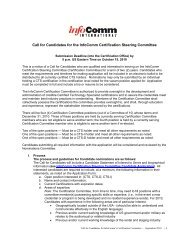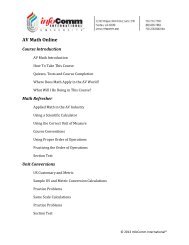Building Information Modeling (BIM) - InfoComm International
Building Information Modeling (BIM) - InfoComm International
Building Information Modeling (BIM) - InfoComm International
Create successful ePaper yourself
Turn your PDF publications into a flip-book with our unique Google optimized e-Paper software.
<strong>Building</strong> <strong>Information</strong> <strong>Modeling</strong>
-<br />
1<br />
Table of Contents<br />
<strong>InfoComm</strong> <strong>BIM</strong> Taskforce<br />
Members:<br />
David McNell, CTS-D, LEED AP, RTKL (Chair)<br />
Harry Allison, CTS-D, Waveguide<br />
Walter Black, Ph.D., VidCAD Documentation<br />
Programs<br />
Michael Cukrow, Middle Atlantic Products<br />
Kevin Harrison, Stardraw.com<br />
Todd Hutchins, CTS-D, Verrex Corporation<br />
Casey Sherred, Acoustic Dimensions<br />
Max Shirley, CTS-D, RCDD, Newcomb & Boyd<br />
Roneel Singh, CTS, WSP Lincolne Scott<br />
David Wilts, LEED AP BD+C, Crestron Electronics<br />
Foreword 2<br />
Introduction to <strong>BIM</strong> in AV 3<br />
Benefits of <strong>BIM</strong> 7<br />
Considerations and Limitations of <strong>BIM</strong> 11<br />
Changes to the Delivery Process 13<br />
Key Steps to Successful <strong>BIM</strong> Implementation 15<br />
Business Implications of <strong>BIM</strong> 17<br />
The Future 19<br />
Conclusion 21<br />
Glossary 22<br />
Appendices 24<br />
Appendix I – Industry Association Publications 24<br />
Appendix II – Relevant Blogs/Newsletters 24<br />
Appendix III – Websites/Resources 24<br />
Appendix IV – Software 25
2<br />
Foreword<br />
The intent of this document is to give the <strong>InfoComm</strong> membership a strong understanding of what <strong>Building</strong><br />
<strong>Information</strong> <strong>Modeling</strong> (<strong>BIM</strong>) is and to also provide a detailed look at what it means to the audiovisual professional<br />
both now and in the coming years.<br />
The information provided in this document is a summary of industry reports, studies, surveys and editorials as<br />
viewed with an eye toward the audiovisual industry. This document details current state-of-the-industry information<br />
with respect to processes, statistics, software applications and resources.<br />
This document provides a detailed look at the benefits and drawbacks of utilizing <strong>BIM</strong>, how <strong>BIM</strong> will affect the<br />
project delivery process, how to successfully begin implementing <strong>BIM</strong> and its business implications, and a look<br />
toward the near and distant future of what <strong>BIM</strong> means to the audiovisual industry.<br />
The construction process involves many stakeholders. While this document is primarily intended for audiovisual<br />
designers and installers, an attempt has been made to introduce and detail the greater <strong>BIM</strong> picture. The intent is<br />
to help the reader understand how the audiovisual professional’s work fits with other portions of the construction<br />
industry.<br />
The use of <strong>BIM</strong> is the backbone of new, leaner design and construction methods such as Integrated Project<br />
Delivery (IPD) and Virtual Design and Construction (VDC). The ability that <strong>BIM</strong> provides to design, construct and<br />
operate a building virtually will prove to be an important instrument to increase productivity while at the same time<br />
improve the quality of work.<br />
Additionally, <strong>BIM</strong> will be valuable in developing more sustainable buildings and their related systems. As sustainable<br />
design becomes the standard and not the exception, <strong>BIM</strong>’s ability to capture and manipulate large amounts of<br />
data related to the built environment will prove to be an invaluable tool.<br />
It is difficult to accurately and fully describe an emerging body of technologies in real-time. Therefore, this<br />
document is not intended to be an academic evaluation of the technology and application, but rather to give<br />
readers a head start on preparing their organization for the changing face of the design, construction and facilities<br />
management industry.<br />
<strong>InfoComm</strong> members are encouraged to discuss this document and <strong>BIM</strong> in general by joining the <strong>BIM</strong> eGroup in<br />
the <strong>InfoComm</strong> Community: http://community.infocomm.org.
3<br />
Introduction to <strong>BIM</strong> in AV<br />
Recently, a quiet revolution has been taking place which will fundamentally change the very fabric of the audiovisual<br />
design and integration business. This revolution is the increased utilization of <strong>Building</strong> <strong>Information</strong> <strong>Modeling</strong> (<strong>BIM</strong>).<br />
<strong>BIM</strong> is described as:<br />
… a digital representation of physical and functional characteristics of a facility. As such it<br />
serves as a shared knowledge resource for information about a facility forming a reliable<br />
basis for decisions during its life-cycle from inception onward. 1<br />
To under stand the reason <strong>BIM</strong> is ascending in importance for the AV professional, we need to consider several<br />
facts.<br />
1. <strong>Building</strong>s consume huge proportions of our scarce resources. Resource allocation and reduction are major<br />
drivers toward <strong>BIM</strong> implementation, whether it be using renewable or recycled materials or reducing energy<br />
consumption. Stakeholders hope that <strong>BIM</strong> will be key in reducing construction resource consumption.<br />
2. In 2004 the Construction Industry Institute estimated that 57% of money spent on construction is nonvalue-added—which<br />
is WASTE. 2 With the U.S. construction market estimated at US$1.288<br />
trillion for 2008, at 57% waste, over $600 billion per year is being wasted.<br />
Figure 1: A large portion of the money spent in the construction industry is wasted,<br />
especially when compared to the manufacturing industry.<br />
This is a stark condemnation of the construction industry, which we need to examine.<br />
a. The bid process and resultant change orders have become the bane of many construction projects.<br />
More disputes arise and more adversarial positions are staked out because of actual or<br />
perceived changes in a construction project than for any other reason. Aggressive<br />
contractors will threaten slow-downs and work stoppages if they don’t get paid.<br />
Overbearing owners will insist that unknown conditions, extra features, and an expanded<br />
project are covered by the original bid price. 3<br />
The major culprit here is probably the design-bid-build paradigm, in which each bidder should complete a rough<br />
design in order to provide accurate bids. However, since this is not paid, and even if a company wins 1 out of<br />
10 bids, the engineering time for all 10 bids will be aggregated into its winning job. Plus, if you gave accurate<br />
bids, you would probably not be the low bidder. The bid is then written in such a way that any deviations result<br />
in change orders, normally paid by the owner. This leads to cost overruns, delays, antipathy and errors.<br />
Some owners prefer the design-build paradigm, which favors one contractor and one AV integrator. If the<br />
project is specified correctly, this reduces the bidding costs, but there is no communications vehicle between all<br />
of the contractors, causing change orders because a wall or ductwork appears where the AV system was to be<br />
installed. Thus, traditional design-build may reduce certain costs, but not eliminate errors and change orders.<br />
1 United States National <strong>BIM</strong> Standard V1, P1 Jan 2008<br />
2 Eastman et al, <strong>BIM</strong> Handbook, 2009, John Wiley and Sons<br />
3 George Berger, Change Orders -- The Bane of All Construction Projects, ForConstructionPros.com, July 8, 2008
4<br />
The alternative to the design-bid-build and design-build paradigms is Integrated Project Delivery (IPD) — where<br />
all stakeholders share in the risk of the design and build process, and share in the rewards of productivity<br />
increases. IPD works well if there is an accurate <strong>BIM</strong> within which the project is designed.<br />
b. There has been no productivity gain in the construction industry over the last 40 years — in fact, there has been<br />
a steady decline, whereas all other non-farming industries rose over 200% in productivity.<br />
Figure 2: Teicholz Construction Productivity Index Graph. Indexes of labor productivity<br />
from construction and non-farm industries, 1964 - 2004 4 , indicates no productivity gain<br />
in the construction industry.<br />
Yet during this time period, we have implemented many labor-saving machines and design tools, including:<br />
PC Computer Aided Design (CAD) — AutoCAD v1 shipped December 1982<br />
Spreadsheets — VisiCalc released first PC Spreadsheet in 1979, Lotus 1-2-3 released in 1982<br />
PC Database — dBase II released in 1980<br />
c. <strong>Building</strong>s are becoming more complex and are taking longer to build.<br />
One thing is certain, in either a shrinking or booming construction market, increasing productivity and coordination<br />
is imperative. A key tool for accomplishing this is <strong>BIM</strong>.<br />
Why are Traditional 2D or 3D CAD Drawings Insufficient?<br />
Current building practice relies upon drawings. <strong>Building</strong> designs are communicated through dozens or even<br />
hundreds of separate, often inconsistent documents. However, CAD documents usually exclude the very<br />
information necessary for effective design evaluation and construction, such as bid and contract documents, Bills<br />
of Materials (BOMs), timelines, specifications, price lists, installation and maintenance guides, cable lists and labels.<br />
<strong>BIM</strong> is more than drawings — it is a data repository for building design, construction and maintenance information<br />
combined in one convenient model to share with all the stakeholders. As these stakeholders increase their<br />
commitment to project success using <strong>BIM</strong>, they should also profit from <strong>BIM</strong> combined with IPD.<br />
This is why the new buzzword is modeling, instead of drawing.<br />
4 Paul Teicholz, “Labor Productivity Declines in the Construction Industry: Causes and Remedies.” AECBytes, April 14, 2004
5<br />
The information that was sufficient for CAD drawings is often insufficient to meet the<br />
requirements of a model-based design process, as industry expectations for analysis using<br />
a model-based approach are expanding.<br />
The purpose of <strong>BIM</strong> is to make the design information explicit, so that the design intent and<br />
program can be immediately understood and evaluated. A <strong>BIM</strong>-based approach supports<br />
‘on demand’ generation of documents (e.g., drawings, lists, tables and 3D renderings)<br />
from a consistent <strong>BIM</strong>. In a sense, these documents present views of the current <strong>BIM</strong>. A<br />
<strong>BIM</strong> model, therefore, can live longer, contribute more to process efficiency, and provide<br />
superior accuracy than traditional 2D CAD drawings.<br />
As a shared knowledge resource, <strong>BIM</strong> can reduce the need for re-gathering or re-formatting<br />
information. This can result in an increase in the speed and accuracy of transmitted<br />
information, reduction of costs associated with a lack of interoperability, automation of<br />
checking and analysis, and unprecedented support of operation and maintenance activities. 5<br />
The Status of <strong>BIM</strong> for the AV Professional<br />
Currently, Autodesk Revit is the predominant <strong>BIM</strong> platform for architects and building owners who are both leading<br />
the transition to <strong>BIM</strong>. But Revit is not the only option. The U.S. Army Corps of Engineers, the California Department<br />
of Transportation and others use Bentley <strong>BIM</strong>. The U.S. General Services Administration (GSA), owner of the most<br />
U.S. buildings, does not endorse any single program, but promotes interoperability. 6 The American Institute of<br />
Architects (AIA) has also issued its own statement promoting interoperability in <strong>BIM</strong>. 7 Even Autodesk and Bentley<br />
have pledged to become interoperable. 8<br />
The buildingSMART alliance was formed to encourage interoperability standards. Their purpose is:<br />
buildingSMART alliance has been established to coordinate the profound changes<br />
coming to the fragmented real property industry in North America. Our collective goal is<br />
open interoperability and full lifecycle implementation of building information models. 9<br />
The primary vehicle for interoperability is the Industry Foundation Class (IFC), definitions which allow the various<br />
<strong>BIM</strong> software programs to interchange data between their models. The U.S. National <strong>BIM</strong> Standard is the<br />
developer of the IFC standard in conjunction with the <strong>International</strong> Technical Management Committee (ITM), an<br />
international alliance supporting the development and testing of IFCs and <strong>BIM</strong> practices.<br />
Innovations in <strong>BIM</strong> Impacting the AV Professional<br />
The world will see many major innovations in the <strong>BIM</strong> market that will have major impacts upon the AV<br />
professional. Here are a few examples:<br />
3D Design: 3D visualizations allow customers to see historic preservation and site context with respect to the<br />
new project. They also allow for 3D coordination to reduce RFIs, errors and omissions 10<br />
4D Design (Time): Adds project phasing and construction sequencing to be added to the model<br />
4D modeling is the integration of a 3D (or <strong>BIM</strong>) model with a construction schedule in order to visualize the<br />
sequence of construction. 4D models can be created to various levels of detail, from high-level zone analysis<br />
during the design phase, to detailed subcontractor coordination during construction. The same model can be<br />
updated and maintained throughout the project based on the updated schedule and 3D model 11<br />
In a 4D <strong>BIM</strong>, you would be notified that you cannot schedule installation of tie-lines until after the delayed cable<br />
trays have been installed<br />
5D Design (Cost): Automated Quantity Take-Offs (QTO) and cost estimating, including the relationships between<br />
quantities, costs and locations<br />
Collision Detection: Automated ways for examining spatial and sequencing conflicts within a <strong>BIM</strong>. For instance,<br />
imagine automated notification that your speaker now collides with the revamped air ducts.<br />
Construction Operations <strong>Building</strong> <strong>Information</strong> Exchange (COBIE): COBIE is an information exchange format<br />
to capture the information created during design, construction and commissioning and allows this information<br />
5 GSA <strong>BIM</strong> Guide Series 1, www.gsa.gov/bim, p. 4<br />
6 GSA <strong>BIM</strong> Guide Series 1, www.gsa.gov/bim, p. 11<br />
7 Interoperability Position Statement, http://aia.org/aiaucmp/groups/aia/documents/pdf/aiab082297.pdf, December 2009<br />
8 Autodesk and Bentley to Advance AEC Software Interoperability, July 2008 http://www.bentley.com/en-US/Corporate/News/<br />
News+Archive/2008/Quarter+3/Autodesk+Bentley+Agreement.htm<br />
9 www.buildingsmartalliance.org<br />
10 GSA <strong>BIM</strong> Guide Series 3, www.gsa.gov/bim, p. 14<br />
11 GSA <strong>BIM</strong> Guide Series 4, www.gsa.gov/bim, p. 2, 3
6<br />
to be passed directly to the building operator. Now, the information from the model is passed directly into the<br />
owner’s facility management program — without paying again for the same data.<br />
Engineering analysis: Detailed energy modeling and acoustical analysis can be performed utilizing data already<br />
in the model.<br />
The Anticipated Result of <strong>BIM</strong> is Consistent Savings in <strong>Building</strong> Life<br />
Cycle<br />
It is no longer a question of whether <strong>BIM</strong> will impact our industry — it has and it will. In considering options for<br />
corporate strategy, keep in mind the desired results of <strong>BIM</strong>:<br />
While only a very small portion of facility life-cycle costs occur during design and construction,<br />
those are the phases where our decisions have the greatest impact. Most of the costs<br />
associated with a facility throughout its lifecycle accrue during a facility’s operations and<br />
sustainment. Carnegie-Mellon University research has indicated that an improvement of just<br />
3.8% in productivity in the functions that occur in a building would totally pay for the facility’s<br />
design, construction, operations and sustainment, through increased efficiency. 12<br />
What is the Future for the AV Professional?<br />
<strong>Building</strong> life-cycle efficiency is not only the true goal of <strong>BIM</strong> and all its stakeholders, but it is imperative for the AV<br />
profession. The responsibility for the model does not end with as-built documentation. The goal must not only be to<br />
design it better, build it better, but also these tasks must be completed in such a way that the facility is maintainable.<br />
The path forward is becoming clearer: design professionals, contractors and building owners are moving toward<br />
<strong>BIM</strong>. This does not mean that all projects require <strong>BIM</strong>, but it is increasingly being required for major construction<br />
and retrofit projects.<br />
Each major AV professional stakeholder must consider how <strong>BIM</strong> impacts him or her, including:<br />
Consultant<br />
As you move into <strong>BIM</strong>, you must input more information into the model. Will you be involved early in the conceptual<br />
stage, where your impact will be multiplied if the building is to be AV- and IT-centric? Are you increasing your<br />
liability and/or your profit potential? Are you also willing to share your <strong>BIM</strong> objects or try to protect them as your<br />
intellectual property? How will your role change as architects want you to provide nearly real-time responses to<br />
their changes? What will be the differentiation between the consultant role and the integrator? Are you prepared for<br />
design-build and IPD?<br />
Integrator<br />
Will you be involved earlier in the design stage, where your impact will be greater? Do you have a plan for<br />
developing your <strong>BIM</strong> proficiency so you will not create your drawings in 2D and hire someone else to put them into<br />
the model? Are you poised to take the risk and profit potential from design-build and IPD? Are you prepared to<br />
change to an AV life-cycle integration and maintenance business model?<br />
System Designer<br />
Are you a <strong>BIM</strong> novice or champion? Are you prepared for the fast turn-around which will probably be demanded<br />
from the other stakeholders?<br />
Thus far, low-voltage signal diagrams are not normally created in <strong>BIM</strong>, but connected objects must all be created<br />
in <strong>BIM</strong>. Signal diagrams are often referenced into the <strong>BIM</strong>, but manual updates of the referenced drawing must<br />
be done. For <strong>BIM</strong> to be truly integrated into the AV professional’s arsenal, it is imperative to maintain excellent<br />
linkage between your CAD diagrams and your <strong>BIM</strong> platform. Are you prepared to have 100% linkage? Even after<br />
the building is constructed, will your design and detailing stand the life-cycle reality tests? In other words, can the<br />
owner easily and economically maintain the infrastructure as modeled?<br />
Manufacturer<br />
Participation in <strong>BIM</strong> is more than building products and delivering CAD drawings on your website. It is more than<br />
contracting with somebody to convert your 3D CAD drawings to <strong>BIM</strong> objects. It is partnering with the consultants<br />
and integrators to easily provide not only the model objects at the level of detail required for their model, but also<br />
providing the pricing, installation and maintenance materials in ways which can meet the owner’s needs for the life<br />
cycle of the model.<br />
12 N<strong>BIM</strong>S_v1_p1, pg. 1.
7<br />
Benefits of <strong>BIM</strong><br />
<strong>BIM</strong> and IPD afford manufacturers, designers and integrators advantages in design efficiency and quality control.<br />
A single, connected model improves communication within the design and construction teams and the parametric<br />
elements of the model create a robust database. The building owner and facility manager can utilize the data within<br />
the model during the occupation of the building. Harvesting the information in that database can help everyone be<br />
more efficient and also create new opportunities for revenue expansion. <strong>Modeling</strong>, instead of drawing, is the new<br />
paradigm, fostering new cooperation, innovation and building life-cycle savings.<br />
<strong>Modeling</strong> vs. 2D Drafting<br />
<strong>Building</strong> modeling improves over 2D drafting by allowing designers to view the building and its contents from<br />
all angles, and revealing problems at earlier stages to allow for correction without costly change orders. Truly<br />
parametric design saves time by creating and editing multiple design portions simultaneously. Sections, elevations<br />
and three dimensional views can be created instantly, reducing the need for check plots. Changes to any one of<br />
these elements affect all of the others, including materials, costs and construction schedules. The two-dimensional<br />
printed documentation becomes the quick and accurate byproduct of parametric design.<br />
Figure 3: 3D perspective views of buildings can be quickly generated using <strong>BIM</strong> software.<br />
Parametric Elements<br />
Parametric elements allow for the creation of large, versatile sets of building components with little effort. One<br />
generic element can serve as a template with predefined ranges of characteristics. This parametric data allows the<br />
element to be easily reconfigured to suit the unique requirements of implementation in various areas of the model.<br />
The following are examples of parametric data and element relationships:<br />
Chairs are arranged evenly across an elevation. If the length of the elevation is changed then the equal spacing<br />
of the chairs will be maintained. The data parameter in this case is proportional.<br />
The edge of an electrical box is related to an interior wall such that when the wall is moved, the electrical box<br />
remains connected. In this situation, the parameter is association or connection.<br />
The parametric data in a collaborative model can also save time during the design process and the construction<br />
administration phase by improving coordination and reducing the need for additional site visits, printing and<br />
manual drawing checks. Changes and additions to building elements update simultaneously across all views,<br />
schedules and sheets.
8<br />
Figure 4: The type properties window shows parameter data for a pendant light fixture.<br />
Change Management<br />
Parametric elements that are changed in one location change in all corresponding views and locations. Warnings<br />
and flags can also be created between elements to allow managers to see element changes in any view. These<br />
warnings can be arranged into an element change report to facilitate coordination.<br />
Leveraging Data<br />
The <strong>Building</strong> <strong>Information</strong> Model is a database that contains manufacturer information, pricing, physical information<br />
(such as weight, size, and material finish) and electromechanical data for many of the devices in the building.<br />
Leveraging this data means that very accurate material schedules can be created from the parametric model<br />
elements and they will change automatically with visual component. Having accurate material schedules allows<br />
designers and integrators to project material usage before construction is complete and to create real-usage<br />
reports for building management after construction. Additionally, this data contained in the model can be used to<br />
identify and create manufacturer ubiquity to ease with service, or if desired, reveal opportunities for manufacturer<br />
variety.<br />
Parametric data can be used to populate any database application and extracted to create take-offs, usage<br />
reports, and in some cases, shortcuts for photo-real rendering applications.<br />
Value-Added Tasks<br />
A powerful <strong>BIM</strong> adopter can turn commodity lighting level recommendations into a value-added Lighting for<br />
AV Study service, with included 3D renderings to demonstrate the need for appropriate video-teleconferencing<br />
lighting. Accurate photometric studies that are focused on AV can be marketed as added service.<br />
The availability of building information that is inherent to the model aids in the generation of reports that may be<br />
provided to the client as value-added services. Power and heat load calculations can be converted into green<br />
AV reports. These reports can also be generated from building power usage data after the building is occupied.<br />
Because accurate usage data can be collected and stored in the <strong>Building</strong> <strong>Information</strong> Model, new value can be<br />
added to predictive usage reports.<br />
Room drawing snapshots to accompany a training manual can be transformed into an online training manual<br />
which includes a user experience walk-through video. New usage scenarios can be explored after occupancy, and<br />
new training demonstrations can be created and sold.
9<br />
Improved Coordination<br />
With <strong>BIM</strong>, detailed information about each building component is contained within its modeled element. <strong>BIM</strong> allows<br />
all team members easy access to information, such as power consumption and weight, to verify that the building<br />
element in question will be compatible with the components of the building for which they are responsible. <strong>BIM</strong><br />
improves coordination among team members by making design changes, and all consequences of those changes,<br />
evident and available to all users of the model and to all parametric model elements. <strong>Building</strong> element collision with<br />
AV devices can be caught early and clearly communicated to every member of the design and construction teams.<br />
Design team members stay in sync with one another’s progress, leaving no trade trying to play catch up after a<br />
release.<br />
<strong>BIM</strong> makes it possible to quickly create sections and elevations of a room without the need to create them from<br />
scratch or ask the architect to provide sketches.<br />
The synchronized and collaborative nature of <strong>BIM</strong> allows for earlier clash detection between the numerous<br />
members of the design team. When areas of conflict are identified earlier, conflicts over space allocation are<br />
initiated and resolved sooner. Earlier clash detection therefore shortens the time required for building design<br />
and reduces costs associated with correcting clashes that were undetected during design reviews. Interference<br />
detection with <strong>BIM</strong> is as simple as identifying the elements that need to be checked and running a report. Clash<br />
detections also happen as elements are moved or added.<br />
Figure 5: An interference check performed in Revit can identify conflicts earlier than past methods of clash detection.<br />
Improved Accuracy and Efficiency<br />
<strong>BIM</strong> affords integrators increased accuracy for quantity takeoffs. Metadata attached to objects allows for accurate<br />
counting and price modeling, improving the accuracy of bids and project pricing. Designers can enjoy receiving<br />
fewer requests for information and change orders. Integrator scheduling based on material availability and<br />
construction progress can be mapped visually. This allows project managers to quickly optimize construction<br />
schedules with ever-changing material deliveries, seasonal costs and availability.<br />
<strong>BIM</strong> helps reduce errors and omissions (E&O) which should in turn reduce E&O claims and professional liability. A<br />
reduction in insurance costs, bonding fees and a positive impact on firm reputation should increase the number,<br />
scale and variety of opportunities available to design and integration firms.
10<br />
Delivery Process Efficiencies<br />
Design and drawing production requirements should evolve so that managers, designers and drafters spend<br />
less time developing designs and more time providing creative solutions for clients. The physical demand for the<br />
creation of multiple views of a building in 2D can be reduced to a short time with a <strong>BIM</strong> solution. A workflow shift<br />
should begin to occur in design departments following the adoption of <strong>BIM</strong> practices, moving away from lowerlevel<br />
drafting positions and toward the creation of more technical design positions.<br />
Electronic reviews of every portion of the building design including equipment schedules, room views, system<br />
designs, fabrication schedules, green building information, pricing and more are possible as <strong>BIM</strong> is the single<br />
repository for all of this information. With the possibility of full electronic reviews, delivery to the client can be<br />
expedited.<br />
Virtual conflict resolution saves time and money over traditional conflict resolution by providing a clear and<br />
automatic view of conflicting issues and a quick demonstration of the resolution paths.<br />
Parametric <strong>Building</strong> <strong>Information</strong> Models allow for the discovery of design errors early and significantly reduce the<br />
probability of extensive redesign. Model elements that are dependent upon one another maintain their relationships<br />
throughout changes to either element. For example, an electrical outlet in a wall will remain at the correct location<br />
in the wall if the wall is moved. The cost of repairing design errors increases as the project design progresses and<br />
the earlier discovery of these errors lessens schedule overrun from redesign.<br />
Client Satisfaction<br />
Visual verification of design intent and knowledge sharing through Virtual Design and Construction (VDC) and <strong>BIM</strong><br />
make for happier clients. The rapid preparation and exchange of visual information mitigates the time needed for<br />
communicating complex ideas and allows more time to be creative for your clients, which should result in repeat<br />
business and excellent references.<br />
Ongoing Technology Management<br />
Technology professionals can use the information in a model to schedule routine maintenance, plan special events,<br />
tie to room scheduling applications and issue trouble reports to technology service personnel. The administration<br />
of service contracts can become more predictive and less reactive. Parts replacement becomes easier and quicker<br />
and maintenance can be completed with fewer errors.<br />
Facility Management<br />
<strong>BIM</strong> can link data from manufacturers, construction data and communications into one fully integrated and robust<br />
facility dashboard. Facility managers can use <strong>BIM</strong> to gather usage data, prepare maintenance schedules using<br />
predictive data, manage daily operations and plan for future purchases and construction additions. Full equipment<br />
data including operating parameters, usage data, predictive data, service history, replacement price and links to<br />
other manufacturer data, combined with a fully rendered 3D depiction of the equipment creates a powerful tool for<br />
facility managers.
11<br />
Considerations and Limitations of <strong>BIM</strong><br />
<strong>BIM</strong> has the potential to improve the communication and coordination between the different stakeholders of a<br />
project. <strong>BIM</strong>’s benefits range from simple improvements in efficiency and coordination to greater client satisfaction.<br />
With all of the perceived benefits of <strong>BIM</strong>, AV professionals should also be aware that there are a number of<br />
considerations and current limitations that must be taken into account.<br />
Cost of Software and Hardware<br />
Every organization currently utilizing 2D or 3D CAD drafting software can attribute a cost element against<br />
purchasing, maintaining and upgrading software licenses to keep a competitive market advantage. Current trends<br />
show that the cost of <strong>BIM</strong> software packages tends to be more expensive than CAD software packages available<br />
on the market.<br />
With the introduction of <strong>BIM</strong> software, the requirements on hardware have increased significantly. Currently, CAD<br />
software can be operated (with limitations) on a vast majority of professional laptops. Yet with the introduction of<br />
<strong>BIM</strong> software, dedicated high-specification workstations, equivalent to those required by advanced modeling and<br />
rendering software, are required.<br />
Software and program requirements are ahead of hardware availability. With <strong>BIM</strong> software, it is essential to know<br />
exactly what parameters of the hardware improve performance and what elements have no major effect at all.<br />
More details on the hardware requirements for <strong>BIM</strong> software may be found in the Getting Started section.<br />
Cost of Training<br />
With new software, there is a great demand to train staff quickly so that the investment can be justified. It is not<br />
realistic to assume professionals with CAD proficiency will be able to learn new <strong>BIM</strong> software quickly or without<br />
specialized training. Given the fundamental differences between <strong>BIM</strong> and CAD, training should be considered a<br />
requirement for all professionals involved with designing and producing documentation.<br />
<strong>BIM</strong> provides the ability for every member of the team to be involved in the design and modeling process, giving<br />
them complete control of the end product. Investment in training for early adopters provides them a competitive<br />
edge with projects that have clearly specified requirements to be documented utilizing <strong>BIM</strong>.<br />
Transition from Drafting to <strong>Modeling</strong><br />
When moving from a CAD-based drafting environment to a <strong>BIM</strong>-based modeling environment, a change in the<br />
workflow will surround what used to be simple drafting tasks such as copying markups or picking up redlines.<br />
These tasks now require a higher-level skilled design drafter who has an understanding of the project and the<br />
materials used. The costs associated with training and maintaining a skilled design modeler are higher than a<br />
draftsman with no knowledge of the trade. Some companies may even be compelled to stay out of the <strong>BIM</strong> world<br />
altogether due to the time- and knowledge-intensive nature of <strong>BIM</strong>.<br />
The transition from traditional CAD will also place an increased level of responsibility on the designer to ensure that<br />
all system components are coordinated with the other design professionals such as architecture and engineering<br />
services and that site issues are reduced to a minimum.
12<br />
Companies have a few different business models to consider when thinking about staff training with respect to <strong>BIM</strong>.<br />
The first option involves the training of current designers to undertake all of their design work in the <strong>BIM</strong><br />
environment.<br />
The second involves up-skilling all of their drafting staff to a higher technical level to undertake design<br />
responsibilities.<br />
The third is a combination of the first two where there is a specific set of rules and guidelines for mark-ups so<br />
that design mark-ups can be translated into the model clearly and efficiently.<br />
In any case, the <strong>BIM</strong> process allows for coordinated delivery earlier in the design process so that potential double<br />
handling or redesign is avoided. This benefit outweighs the cost of any additional training to up-skill staff no matter<br />
what business model for the delivery of <strong>BIM</strong> projects.<br />
Compatibility Between Software Platforms<br />
One of the biggest issues with early adaptors of <strong>BIM</strong> is the issue of inter-product compatibility. Due to the<br />
relatively new nature of the market, every software manufacturer is doing something different with its software.<br />
This interoperability challenge can make it difficult for projects to function if different team members own different<br />
software packages.<br />
This interoperability issue is not limited to different software platforms; due to the rapid development of the <strong>BIM</strong><br />
software industry newer versions of programs within the same platform can have interoperability issues.<br />
One alternative to the current product-specific models is a vendor-independent, neutral-file format. One such file<br />
format is the Industry Foundation Classes (IFC) format which captures both geometry and properties of intelligent<br />
building objects (objects with associated usable metadata) and their relationships within <strong>Building</strong> <strong>Information</strong><br />
Models, thus facilitating the sharing of information across otherwise incompatible applications.<br />
Innovation<br />
Since a goal of <strong>BIM</strong> is to assign constraints and parameters to intelligent objects to improve efficiency, there is a<br />
potential to inhibit innovation which would possibly otherwise occur without the automated processes and shared<br />
knowledge that <strong>BIM</strong> now provides. Those firms implementing <strong>BIM</strong> should view the parameters and metadata<br />
constraints as a global database that allows designers to save time associated with updating and configuring<br />
product-specific data repetitively on different projects, hence increasing the amount of time spent on system<br />
design and innovation.
13<br />
Changes to the Delivery Process<br />
The delivery process is the method by which a project is taken from initial, conceptual programming, through<br />
design and construction to the delivery of a completed facility to the owner. Prior to the introduction of <strong>BIM</strong> for<br />
design and documentation, traditional project delivery methods such as Design-Bid-Build (also called Design-<br />
Award-Build) dominated the construction industry. While these traditional methods are still very much in use, there<br />
has been a strong movement toward more streamlined processes to reduce construction times and enhance<br />
collaboration of team members. The Design-Build delivery method is one example of this streamlining. By taking<br />
the competitive bid phase out of the middle of the delivery process and placing the entire design contract under<br />
the scope of the general contractor, there is no longer a procedural or contractual separation between the design<br />
and construction of the project. The owner only has to carry one contract for both design and construction<br />
services. This allows for the construction to begin well in advance of the completion of all design documentation as<br />
the design documentation is produced in concert with the construction almost on an as-needed basis.<br />
While the Design-Build methodology is perhaps more efficient than Design-Bid-Build, these “traditional” methods<br />
both share some fundamental flaws which the newest delivery method, Integrated Project Delivery (IPD), is capable<br />
of eliminating.<br />
Because IPD is so new there is no official definition, however the California chapter of the AIA offers this working<br />
definition:<br />
Integrated Project Delivery (IPD) is a project delivery approach that integrates people,<br />
systems, business structures and practices into a process that collaboratively harnesses<br />
the talents and insights of all participants to reduce waste and optimize efficiency through<br />
all phases of design, fabrication and construction. Integrated Project Delivery principles<br />
can be applied to a variety of contractual arrangements and Integrated Project Delivery<br />
teams will usually include members well beyond the basic triad of owner, architect and<br />
contractor. At a minimum, though, an Integrated Project includes tight collaboration<br />
between the owner, the architect, and the general contractor ultimately responsible for<br />
construction of the project, from early design through project handover. 13<br />
Project Factor Traditional Delivery Integrated Delivery<br />
Team Fragmented, assembled on “as-needed” or<br />
“minimum necessary” basis, very hierarchical,<br />
controlled<br />
Process Linear, distinct, segregated, knowledge gathered<br />
“as-needed”, information hoarded, silos of<br />
knowledge and expertise<br />
Risk Individually managed, transferred to the greatest<br />
extent possible<br />
Reward/Compensation Individually pursued, minimum effort for<br />
maximum return, often first cost-based<br />
Communication/<br />
Technology<br />
Integrated team entity of key stakeholders, assembled<br />
early in the process, open, collaborative<br />
Concurrent and multi-level, early contributions of<br />
knowledge and expertise, information openly shared,<br />
trust and respect<br />
Collectively managed, appropriately shared<br />
Team success tied to project success, value-based<br />
Paper-based, two dimensional, analog Digital, virtual, <strong>Building</strong> <strong>Information</strong> <strong>Modeling</strong>, 5+<br />
dimensional<br />
Agreements Encourage unilateral effort, allocate and transfer<br />
risk, no sharing<br />
Encourage, foster, promote and support multilateral<br />
open sharing and collaboration, risk sharing<br />
Figure 6: A comparison of traditional delivery methods vs. IPD methods on key project processes reveals<br />
the advantages of IPD. 14<br />
While IPD is seen as the possible future of project delivery that is being fueled by <strong>BIM</strong>, it is still the exception and<br />
not the rule. Before IPD becomes commonplace on all projects, a transitional period will ensue during which<br />
delivery requirements will begin to change as well as the relationships and expectations of the owner, designer,<br />
integrator and manufacturer.<br />
13 Integrated Project Delivery: A Guide, www.aia.org/ipdg, Foreword.<br />
14 Integrated Project Delivery: A Guide, www.aia.org/ipdg, p 1
14<br />
Owners will become more involved in all aspects of the project simply because the model will provide them<br />
immediate and vast information. Rather than having to try to interpret a stack of 2D plans, owners now have<br />
access to an immense amount of information which can be formatted to meet their needs. This includes virtual<br />
walkthroughs, detailed equipment lists and accurate cost estimates.<br />
<strong>BIM</strong> allows for the building to be built in a virtual environment before being actually built. With this change,<br />
designers will become more involved in decisions which might previously have been considered “means and<br />
methods” and left to the contractor to figure out during the installation. Some examples include more detailed<br />
routing of infrastructure and placing devices in their exact location.<br />
<strong>BIM</strong> acts as a central database for the project and as such it is regularly evolving. Due to this constant state of<br />
flux, expectations must be set and agreed to among team members regarding the expected level of completion<br />
at various points during the project. Most projects consist of multiple models which are linked together. These<br />
models are typically exchanged between team members on a regular schedule whether it be weekly or daily. These<br />
exchanges are independent of the major scheduled deliverables of the project such as 50% Design Development<br />
or 90% Construction Documents. When these models are shared, they are usually not in a completed state;<br />
therefore, there must be an understanding between parties about the level of completion and coordination<br />
expected for model exchanges between the deliverables established by contract.<br />
The entire project team will have increased communication and will begin to work as one entity rather than<br />
separate team members who only exchange documents at predetermined milestones. The model will become a<br />
consolidated design document which evolves on a constant basis during design, through construction and into the<br />
management of the facility. This consolidation requires a tighter and more constant information exchange which<br />
sometimes takes place via co-locating of team members either physically or virtually.<br />
In contrast to traditional CAD-based design, <strong>BIM</strong> is a front-loaded process with substantial benefits reaped toward<br />
the end of the process which consist of manipulation of the database’s data points. It should be noted that this<br />
requires substantial effort up front to not only put information into the database but to also collect more data from<br />
the very start. If the data is not available at a given time, there should be an effort made to analyze what data might<br />
or will be required so that the correct pigeon hole can be created in the database from the very beginning. The<br />
model is only as good as the data set that goes in.<br />
Traditional delivery methods invoke inefficiencies because participants are contractually placed into silos of scope.<br />
These silos have a two-fold detriment to the efficiency of a project. First, when any knowledge needs to transfer<br />
from one team member to another, such as from the design team to the contractor, there is inefficiency created<br />
when the contractor has to take the time to get up to speed on the design documents to be able to move forward<br />
with the scope of work. Secondly, a team member’s success is only tied to the success of the individual silo rather<br />
than the overall success of the project.
15<br />
Key Steps to Successful <strong>BIM</strong><br />
Implementation<br />
<strong>BIM</strong> implementation requires proper planning, patience and full commitment from all levels of the organization.<br />
When introducing <strong>BIM</strong> to an organization, proceeding with only a minimum amount of knowledge is a common<br />
mistake and can be costly.<br />
Develop a <strong>BIM</strong> Action Plan<br />
Developing a solid <strong>BIM</strong> action plan should be the first step toward getting your organization up and running in a<br />
<strong>BIM</strong> environment. Without this plan in place it is easy to lose track of what information is required to be successful.<br />
The plan should consist of two major sections: analysis and implementation.<br />
Analysis:<br />
A majority of the plan should be focused on information gathering about current methods, procedures and<br />
business strategy. The transition to a <strong>BIM</strong> workflow is a major shift for any organization on all levels; as such, it is<br />
an excellent time to look deep into your workflow to find any inefficiency that can be fixed. The analysis portion of a<br />
<strong>BIM</strong> action plan should include:<br />
Existing Processes Identification and Analysis<br />
It is important to conduct a detailed analysis of existing internal and external business processes to help establish a<br />
base line for where to start to achieve the goals established later in the plan. This analysis should include a detailed<br />
review of how projects are currently being processed through the organization from initial marketing through<br />
completion.<br />
Technology Analysis<br />
A detailed technology analysis identifies existing hardware and software technologies and their associated costs<br />
utilized by the organization. A review of current document and data management should also be included in the<br />
analysis.<br />
Personnel Analysis<br />
A detailed review of personnel should be conducted to help establish a few key pieces of information by providing<br />
answers to the following:<br />
What are the current roles of your project teams?<br />
Who will need to be trained with the new software?<br />
What level of training will each type of employee require?<br />
How will the new requirements of a <strong>BIM</strong>-based project modify the current make-up of your teams?<br />
Do you still require pure drafters?<br />
Can your current drafters become junior-level designers?<br />
Cost Analysis<br />
The transition from a CAD-based organization to a <strong>BIM</strong>-based organization carries a significant cost impact on<br />
three major fronts:<br />
Hardware: Current <strong>BIM</strong> software requires a higher-performance workstation when compared to a CAD software<br />
on a comparable-sized project. This <strong>BIM</strong> implementation may require a significant upgrade of current systems to<br />
ensure efficient workflow.<br />
Software: <strong>BIM</strong> software will need to be purchased. The best resource for information regarding the best version of<br />
software and support to purchase are the many resellers out there. With resellers you can discuss the details of<br />
your needs and business plan to help identify the correct route to take – whether it is a single license or a full blown<br />
subscription with technical support.<br />
Personnel: Educating and training employees to use <strong>BIM</strong> software and the new associated delivery processes<br />
costs money. This cost will most directly be related to training but there will also be a temporary loss of productivity<br />
while existing processes are transitioned to a new methodology.
16<br />
Once the aforementioned analyses have taken place, the next step is to develop an overall phased strategy for<br />
implementation. The implementation should include:<br />
Timeline<br />
A detailed timeline is required to ensure that the overall strategy is being implemented in a timely and organized<br />
process.<br />
Personnel Changes<br />
A change to a <strong>BIM</strong> delivery process represents a big change to an existing CAD workflow and thus a change to<br />
individual employee roles. The biggest change is a move away from pure drafters. With the <strong>BIM</strong> process focused<br />
around building a project in the virtual environment, those who are interacting with the model require more trade<br />
knowledge to be efficient.<br />
Generally speaking, two new roles will be defined within the organization: a company <strong>BIM</strong> manager and project<br />
<strong>BIM</strong> managers. A company <strong>BIM</strong> manager will lead the charge for the company and be the guiding force behind<br />
implementation, standards development and software decisions. On each project, a project <strong>BIM</strong> manager should<br />
be assigned who is responsible for project-related <strong>BIM</strong> decisions, interacting with other project team members,<br />
<strong>BIM</strong> managers and maintenance of the model.<br />
Training Plan<br />
Training on a <strong>BIM</strong> platform is best completed using a “Just in Time” method. A lot of the concepts involved with<br />
<strong>BIM</strong> are very different when compared with a traditional CAD workflow and therefore are best learned working<br />
on an actual project. A proven method of success is to have multiple training days consisting of half a day for<br />
classroom instruction followed by half a day of actual project work with the instructor available for hands-on<br />
teaching. Training should start with only a small group of employees on a single project so that they can help<br />
streamline the <strong>BIM</strong> workflow prior to getting the entire organization up to speed.<br />
It is also advantageous for at least a single employee to receive in-depth training and then act as the <strong>BIM</strong> manager<br />
for the company. This person can then be the “go-to person” for help and can lead the establishment of standards.<br />
Keys to Success<br />
Successful <strong>BIM</strong> implementation within a company starts with the shared vision of change and buy-in from all<br />
members of the organization. Senior leadership needs to support the change and be willing to sacrifice a little in<br />
the beginning to reap the future rewards.<br />
Other organizations are at all stages of the <strong>BIM</strong> implementation process - from thinking about it, starting to<br />
implement and fully operating in a <strong>BIM</strong> workflow. Additionally, there are many local and regional <strong>BIM</strong> and IPD<br />
groups that meet on a regular basis to discuss <strong>BIM</strong>-related topics. It is important to network with industry peers to<br />
share successes and failures to help better the industry as a whole.<br />
The key to success in any <strong>BIM</strong> project is collaborative effort among all team members, which includes but is<br />
not limited to the project owner, the design team, general contractor, subcontractors and vendors/suppliers.<br />
<strong>Information</strong> data must flow freely between all of the <strong>BIM</strong> project team members to obtain maximum advantages in<br />
a <strong>BIM</strong> project. The project owner plays a central role in leading the discussion and decision-making process when<br />
it comes to applying <strong>BIM</strong> to his/her project.<br />
Use available <strong>BIM</strong> resources to further understand of more advanced <strong>BIM</strong> concepts and practice. Set aside<br />
enough resources to ensure that your organization is not just buying software but is engaging in a business<br />
process that will meet your current and future business needs and opportunities.<br />
With an intelligent implementation of <strong>BIM</strong> technology, your team starts to develop skills and techniques, build<br />
confidence in the software and pace the future work for potential benefits. For your organization it will mean new<br />
opportunities to provide the highest level of product.
17<br />
Business Implications of <strong>BIM</strong><br />
While major shifts occur in design and construction processes utilizing <strong>BIM</strong> and related technology, the<br />
construction industry faces a new set of legal and business challenges. Most of the legal issues stem from the<br />
deep collaboration between trades and firms working in the same building model, affecting liability concerns as<br />
well as reconsidering roles and relationships between trades, firms and stakeholders. In addition, <strong>BIM</strong> is catalyzing<br />
business and operational challenges affecting technology, hiring and training plans across the industry.<br />
Operational Aspects<br />
Companies, depending on their business strategies, roles and internal cultures, will respond differently to the shift<br />
toward virtual design. Some companies will eagerly adopt the new technologies, finding satisfaction in helping<br />
pioneer industry standards and processes despite the apparent costs involved. Other companies will assume<br />
a “wait and see” strategy, resisting adoption as long as possible to make sure they are using a well-vetted<br />
technology before they make a costly switch. Most companies, however, will find themselves between these<br />
opposing strategies, working to keep clients happy while keeping up with industry trends.<br />
In the May 2010 edition of Harvard Business Review, authors David A. Lubin and Daniel C. Esty discuss the<br />
sustainability megatrend affecting so many companies. Of note is the assertion that, like all megatrends, there are<br />
certain phases of adaptation that the most successful company will go through. The following is an adaptation of<br />
their proposed stages as they apply to this document.<br />
Doing Old Things in New Ways<br />
As a starting point, most companies will do their best to reproduce the same types of documentation that they<br />
have produced in the past. Design processes will likely stay the same during this phase as users learn how the<br />
software tools work.<br />
Doing New Things in New Ways<br />
As <strong>BIM</strong> users and managers hone their skills and become comfortable with the tools and technology, they will learn<br />
new ways to leverage the software tools to improve document production as well as refine the design and delivery<br />
processes associated with their trade. For example, real-time coordination with other trades both in the design<br />
phase and construction phase can be utilized in ways rarely possible before.<br />
Transform Core Business<br />
In this stage, <strong>BIM</strong> technology ceases to feel like a revolution and becomes standard operating procedure. Users<br />
and managers are familiar with the usage and advanced capabilities of <strong>BIM</strong>. Design and delivery processes have<br />
been adapted. Businesses may start to see greater returns on their investment in <strong>BIM</strong> as less overhead is spent<br />
procuring equipment, software and training. Further, because of the expertise in an emerging technology and the<br />
fundamental shifts of the industry, entirely new products and services can be explored with the potential of shifting<br />
priorities and business activities.<br />
New Business Model Creation and Differentiation<br />
Once the skills and innovations of <strong>BIM</strong> have been mastered and the company has introduced new services<br />
and methods, a successful company may be able to differentiate itself from peers. The company may be<br />
repositioned as a more critical part of the construction process by offering more, deeper and better services than<br />
its competitors. For example, a designer may be able to provide better visualization and budgetary estimates to<br />
owners for planning purposes, better design coordination with architects and engineers and closer partnership with<br />
integrators by providing equipment schedules, complex coordination details, phasing information and more. True<br />
differentiation may come in the form of assisting clients with life-cycle cost analysis or another key innovation.<br />
It is encouraged to spend as little time as possible in the first stage. Because of the particular challenges of <strong>BIM</strong>,<br />
focusing too much on doing old things in new ways may lead to unnecessary frustration. It is recommended to<br />
quickly move toward intelligently and realistically enhancing your company’s product for all of your clients and team<br />
members.
18<br />
Legal Aspects<br />
Liability<br />
Effective risk allocation strategies place the burden of liability on the entity most able to control the variables<br />
influencing its execution. <strong>BIM</strong> technologies are shifting responsibilities and in so doing are blurring traditional lines<br />
of liability.<br />
Following are some examples representing just a few of the challenges <strong>BIM</strong> technologies pose to traditional risk<br />
allocation models:<br />
In traditional 2D design processes, design coordination between trades is expected and required to ensure<br />
constructability; however, the means and methods of installation are generally left to the constructors to<br />
coordinate between trades and finalize routing of ductwork, cable trays, conduits, etc. Coordination drawings<br />
are often required from the constructors. Utilizing <strong>BIM</strong> technology, the design team goes substantially further<br />
than the traditional model by coordinating with other trades and defining more data in the model. The risk<br />
and liability challenges: Does the standard of care become more complex under <strong>BIM</strong>? Does the design team<br />
assume greater liability for constructability of building systems? Hopefully the builders will encounter fewer field<br />
coordination issues, but when they occur, do the constructors have a lower standard of care and less liability<br />
given that the burden of coordination has shifted toward the design phase?<br />
Few firms today outsource basic CAD drawing work, but given the investment and skill level required, many<br />
firms will be tempted to outsource their <strong>BIM</strong> development work, at least in the short term. Should the third-party<br />
<strong>BIM</strong> developer assume any risk for the accuracy of the model? To what standard of care should they be held?<br />
The database functionality of a <strong>BIM</strong> model is powerful, but the proliferation of data will soon reach a point that<br />
no single person could reasonably be held responsible for all of its accuracy. Assuming that drawings and<br />
specifications will continue to be required to be stamped by licensed professionals, how will this increased<br />
risk of incorrect data be dealt with? Will the practice of holding an individual personally liable persist in the <strong>BIM</strong><br />
paradigm?<br />
Currently few court cases provide insight into the future of <strong>BIM</strong> law, risk and liability. While the details of industry<br />
legal standards are still in transition, it is important to start thinking about how your firm may be exposed in new<br />
ways and attempt to deal with those challenges before they become a problem. Ask your professional liability<br />
insurer if special provisions or vehicles will be recommended or required for work in virtual design.<br />
Contracts<br />
Of immediate concern in any new <strong>BIM</strong>-based project is ownership and control of content. The traditional document<br />
model paradigm allows each team member to largely own and control most of his or her own content. However,<br />
by its nature <strong>BIM</strong> technology allows everyone with access to the model to access any other team member’s<br />
intellectual property.<br />
The major concern that arises stems from the resolution of potential disputes. If an error in the model causes a<br />
problem, it may be difficult to track who made the error and under what circumstances the error was made. If an<br />
error is discovered in the field, for example, it could have been a genuine error by a designer. It could have been<br />
inadvertently caused by another user with access to the model. It could have been unintentionally caused by the<br />
constructor after the designer turned over the model, or it could simply be due to a misunderstanding about the<br />
level of development or intended use of the model.<br />
A thoughtful approach to <strong>BIM</strong> execution should set clear expectations between team members. The American<br />
Institute of Architects (AIA) Document E202, <strong>Building</strong> <strong>Information</strong> <strong>Modeling</strong> Protocol Exhibit, can be used as a<br />
template or guideline for documenting expectations and establishing the level of development and acceptable use<br />
of the content. The intent is to establish how heavily the data entered into the model may be relied upon and in<br />
what contexts.<br />
Even if additional contract language is not imposed, it is advised to produce a <strong>BIM</strong> implementation plan with the<br />
other team members to avoid interoperability, schedule or development problems. Keep in mind when agreeing to<br />
level of development or standard of care that using a third party <strong>BIM</strong> developer to produce the model without the<br />
skills to review and verify the work yourself could expose the company to liability concerns.<br />
It is worth mentioning that the collective and collaborative nature of virtual design has inspired and perhaps<br />
necessitated the introduction of the new project delivery method discussed earlier, IPD. Theoretically, IPD extends<br />
the collaborative design paradigm afforded by <strong>BIM</strong> technology to the entire project delivery by tying each party’s<br />
interests to the project as a whole rather than their own portion. The IPD model has many proponents, but is new<br />
and not without its own risks, including ineffective or costly insurance. Careful consideration and planning should<br />
be implemented for IPD projects.
19<br />
The Future<br />
<strong>BIM</strong> and Virtual Design and Construction (VDC) will continue to grow as 2D design processes recede from<br />
prominence. VDC is being embraced by design and project teams which are looking to leverage <strong>BIM</strong> to the<br />
furthest degree. While the current application of VDC is pragmatic in regard to clash detection and project<br />
coordination, the ability of the design team to virtually model a building’s annual performance overnight is the way<br />
of the future. The dominance of VDC and <strong>BIM</strong> in the design and construction industry will “tip” when it becomes<br />
measurably more efficient, productive and profitable to use that project process.<br />
Near-Term Future (2011):<br />
VDC and <strong>BIM</strong> will continue to grow to be the dominant workflow in larger projects. In fact, many universities as<br />
well as local and federal government projects now require this work process and documentation methodology in<br />
North America. Outside of North America, such as in Abu Dhabi, U.A.E. and Saudi Arabia, many master plans and<br />
building projects require this documentation and workflow as well. Project teams globally are evolving to adopt this<br />
project process as a result of these requirements.<br />
The adoption of a <strong>BIM</strong> workflow is driven by these project requirements as well as by innovative and forwardthinking<br />
architects and design teams. In many instances smaller firms have turned to a <strong>BIM</strong> workflow to better<br />
serve their clients. This workflow and process change has slowed to a certain degree because of the downturn<br />
in the design and construction industry as a whole; however, many architecture and MEP firms are continuing to<br />
make the transition as a way to differentiate themselves from their competitors.<br />
Major architecture firms are looking for the rest of the consultants on the design teams they lead to adopt <strong>BIM</strong><br />
in order to also reduce their production costs. To provide the traditional 2D architectural backgrounds to the<br />
consultants, architects need to add an export step to their project process. If the architects could avoid this step,<br />
which typically happens at least once per project phase, they could be more efficient. Additionally, by working<br />
from the model, the process of getting title blocks, fonts, references, etc., correct across the project can be<br />
accomplished automatically.<br />
This client demand then becomes the incentive for consultants to adopt this workflow to differentiate themselves<br />
and provide a higher value to the architects.<br />
Different types of project processes, such as IPD or design-build, are suited to utilizing a <strong>BIM</strong> workflow. As design<br />
and project teams move away from the design-bid-build project process, <strong>BIM</strong> will become more predominant.<br />
Additionally, in the near future, manufacturers will be providing <strong>BIM</strong> models with their specifications included in the<br />
metadata. This additional information should assist the design teams in accelerating their workflow and creating<br />
more detailed models with no additional effort.<br />
Energy modeling, currently completed by different applications such as eQuest, Trane Trace, Ecotect and IES,<br />
cannot yet gather meaningful, time-saving energy-use metadata from mechanical, electrical, lighting, computer and<br />
AV equipment. As this evolves, potentially leveraging the gbXML metadata text format and/or IFC, manufacturers<br />
will begin to standardize on a methodology that design teams can leverage for energy use monitoring.<br />
Interestingly, a lot of the innovation and adoption is being driven by the construction side of the business. General<br />
contractors, construction managers and trade contractors are pushing the envelope due to the efficiencies that<br />
<strong>BIM</strong> offers.<br />
As an example, through leveraging the <strong>BIM</strong> model, mechanical and plumbing contractors are placing their ceiling<br />
anchors for pipes and ductwork into the concrete slab form before the concrete is poured. This is significantly safer<br />
and faster than hammer-drilling into the slab above one’s head to install and secure the anchors. It does not slow<br />
down the concrete slab construction and allows the interior fit-out work to happen at a faster pace. This innovative<br />
new work process, enabled through <strong>BIM</strong>, makes the process more efficient for the team – as well as safer and<br />
more profitable for the contractor.
20<br />
A Little Further Out (2-4 years):<br />
Construction-Operations <strong>Building</strong> <strong>Information</strong> Exchange (COBIE) could become more widely adopted and<br />
accepted, providing a better value to building owners and facility managers. With a model that is fully populated<br />
with all of the building components, facility managers and owners would have a much more powerful tool with<br />
which to manage a building. The model can become a complete repository of building information and data that<br />
formally had no shared, centralized collection point.<br />
Many firms are also including Construction Specifications Institute (CSI) specification information in the metadata of<br />
the models. A schedule of this metadata can automate the creation of the narrative specification documentation.<br />
Additionally, as the design and bidding process continues to evolve, the model with all of its schedules and<br />
metadata could become the central element in the bidding and pricing process instead of the traditional, 2D<br />
bid package. This transition will be able to occur as more and more designers (architects and consultants) and<br />
constructors (GC/CM/trades) utilize the <strong>BIM</strong> tools that are available, and they can leverage coordination tools such<br />
as Navisworks and Solibri Model Checker.<br />
Some of the biggest changes will occur because of the evolution of both computing processing power and the<br />
further development of the software tools. Currently, <strong>BIM</strong> applications cannot effectively utilize the processing<br />
power that is available in multi-processor computers.<br />
<strong>BIM</strong> applications will hopefully also share the same “model” harmoniously to more fully realize the potential of virtual<br />
design. The following elements will need to evolve in order for this to happen:<br />
<strong>Building</strong> element models will need to be interoperable between the various platforms (ArchiCAD, Revit, Bentley,<br />
etc.). This interoperability is a goal of the Industry Foundation Class, or IFC.<br />
Applicable building element models will contain actual energy-use data depending upon their operation. At a<br />
minimum this would include standby power draw (quiescent), in-use draw, as well as maximum draw. This will<br />
require manufacturers to test and reliably provide this data in a standards-oriented manner within their building<br />
element models. This data could also include a “function use timer” for items like shades, projection screens,<br />
projector lifts, mechanical equipment, appliances, etc.<br />
Plug loads and “process” energy use will be able to be designed based upon the devices that are virtually<br />
“plugged in” in the model.<br />
Lighting panels and electrical panels will be able to be easily designed and configured through the leveraging of<br />
the energy-use data in the model elements.<br />
The energy modeling applications will be able to pull the energy-use data directly from the element models and<br />
build a true, in-use model based upon the power draw of all of the building elements.<br />
Ideally, the energy modeling will also take into account the micro-climate data that is already being leveraged by<br />
applications such as Ecotect.<br />
In the (Hopefully) Not Too Distant Future:<br />
Ultimately, the building model will be able to run virtually in the design phase of the project. With this in mind,<br />
a single model will be able to run and the energy use may be determined automatically based upon the virtual<br />
devices within the building model. This virtual building modeling will empower the design and project team to make<br />
well-informed decisions about all of the building systems and their respective functionality. This analysis will only<br />
be possible once all of the different building models are united into a single model and the design team silos work<br />
cooperatively to maximize efficiency.<br />
Ideally, the virtual building automation “brain” will be able to be transplanted into the actual building upon the<br />
completion of construction. The system should be able to run the real building very efficiently Day 1 because it had<br />
been running the virtual building model prior to being transplanted.
21<br />
Conclusion<br />
The audiovisual professional has an opportunity, with <strong>BIM</strong> and ultimately IPD, to add more value to the project<br />
team. <strong>BIM</strong> and IPD are both important revolutions in the construction and building management industries,<br />
and firms that can quickly become competent adopters will have an edge on the competition. With increased<br />
profitability, reduced professional risk, less waste, less rework and improved efficiency, audiovisual firms can use<br />
<strong>BIM</strong> to create new revenue streams and add to profitability. <strong>BIM</strong> will be the main method in which buildings are<br />
constructed and managed. It is crucial for audiovisual firms to become early and professional adopters of this<br />
technology and embrace the associated cultural change to ensure the growth of our industry.
22<br />
Glossary<br />
2D export Also known as a “2D take-off”. A 2-D export is a set of two-dimensional drawings derived from the<br />
design model. This is required for design team members who are still working in 2D. It is also utilized for pricing<br />
sets and final construction sets for bidding by trades.<br />
4D Leveraging <strong>BIM</strong> for project time allocation and construction sequence scheduling presentations (phasing\<br />
sequencing)<br />
5D Leveraging <strong>BIM</strong> for cost and simulation of construction, focusing on building sequence, cost, and resources<br />
(cost estimating)<br />
<strong>BIM</strong> <strong>Building</strong> <strong>Information</strong> <strong>Modeling</strong>, was coined in early 2002 by industry analyst Jerry Laiserin to describe virtual<br />
design, construction and facilities management. <strong>BIM</strong> processes revolve around virtual models that make it possible<br />
to share information throughout the entire building industry.<br />
BSA buildingSMART Alliance, operates within the independent nonprofit National Institute of <strong>Building</strong> Sciences<br />
(NIBS). This public/private initiative expands on goals of the North American Chapter of the <strong>International</strong> Alliance for<br />
Interoperability (IAI-NA), whose Industry Foundation Classes (IFCs) have initiated open standards for national and<br />
international links among industry players. It provides developers and users of <strong>Building</strong> <strong>Information</strong> Models (<strong>BIM</strong>s)<br />
the digital tools that are increasingly helping to share highly accurate information throughout a facility’s life cycle.<br />
(www.buildingsmartalliance.org)<br />
clash detection is a process of discovering the building system conflicts and issues by collaborating in 3D during<br />
the MEP model coordination process. Sometimes referred to as interference checking.<br />
COBIE Construction-Operations <strong>Building</strong> <strong>Information</strong> Exchange, is a standard way to manage information from a<br />
<strong>BIM</strong> model that is essential to support the operations, maintenance and management of the facilities by the owner<br />
and/or property manager. The COBIE approach is to enter the data as it is created during design, construction<br />
and commissioning. Designers provide floor, space and equipment layouts. Contractors provide make, model<br />
and serial numbers of installed equipment. Much of the data provided by contractors comes directly from product<br />
manufacturers who also participate in COBIE.<br />
constructability model is a <strong>BIM</strong> model used to simulate the actual components of a building in 3D, created<br />
as the building would be built, used primarily for MEP model coordination, 4D simulations and 5D estimating or<br />
quantity take-offs (compare with design model).<br />
CSI Construction Specifications Institute<br />
design model is a <strong>BIM</strong> model developed by an architect from whom the automated construction documents are<br />
derived, along with automated schedules, details and client presentations (compare with constructability model).<br />
energy model is the virtual representation of how a building will consume energy. These models are required to<br />
achieve the highest number of LEED points for energy efficiency. DOE2, eQuest, IES and Ecotect are common<br />
applications for this modeling.<br />
families are parametric 3D building components used in Revit.<br />
gbXML Green <strong>Building</strong> Extensible Markup Language (XML) is a file format standard that allows one energy<br />
analysis program to talk to or interoperate with another. (See XML for more information.)<br />
GDL Geometric Descriptive Language is a scripting programming language exclusive to ArchiCAD software that<br />
writes a .GSM file format.<br />
GIS Geographic <strong>Information</strong> System is a 3D modeling approach that captures, stores, analyzes, manages and<br />
presents data that refers to or is linked to a geographic location.<br />
GreenFORMAT, a classification system in development to assist the construction industry list and find products<br />
using post-consumer, pre-consumer and rapidly renewable content, low-emitting materials and products<br />
complying with ASTM, LEED, ASHRAE and other performance standards. (www.csinet.org)<br />
ICC <strong>International</strong> Code Council is an association dedicated to building safety and fire prevention. ICC develops the<br />
codes and standards used to construct residential and commercial buildings, including homes and schools.<br />
IFC Industry Foundation Class is a data exchange method that specifies elements that are used in building<br />
construction in an agreed manner that define a common language for construction. IFCs provide a foundation<br />
for the exchange and sharing of information directly between software applications of a shared building project
23<br />
model. The IFC data model is a neutral and open specification that is not controlled by a single vendor or group of<br />
vendors. It is an object-oriented file format to facilitate interoperability in the building industry, and is a commonly<br />
used format for <strong>BIM</strong>. The format is known as ifcXML. ifcXML2x3 (current version) is currently supported by<br />
Autodesk, Graphisoft, Nemestchek and Bentley. (www.iai-international.org)<br />
IPD Integrated Project Delivery, a new project workflow method and supporting contracts developed by the<br />
AIA, which leverages early contributions of knowledge and expertise through the utilization of new technologies,<br />
allowing all team members to better realize their highest potentials while expanding the value they provide<br />
throughout the project life cycle. IPD avoids the realization phase challenges by allowing project data to be<br />
analyzed and understood prior to construction.<br />
iRoom, a conference/presentation room dedicated to MEP coordination meeting sessions, usually found on a<br />
job site, managed by the general contractor; a conference/presentation room dedicated to collaboration by all<br />
members of the design and construction team during the IPD approach to project delivery.<br />
MasterFormat is the recognized industry standard for categorizing building products for more than 40 years.<br />
MasterFormat 2004 Edition replaces MasterFormat 1995, expanding the well-known 16 divisions to 50 divisions of<br />
construction information. www.csinet.org<br />
MEP coordination is the process undertaken during pre-construction to uncover any building system conflicts<br />
with mechanical, electrical, plumbing or fire protection systems using 3D models integrated into one master model<br />
that can facilitate interference checking or clash detection.<br />
NCS National CAD Standard, a U.S. government-sponsored standard that coordinates the efforts of the entire<br />
industry by classifying electronic building design data consistently allowing streamlined communication for the<br />
industry. (www.buildingsmartalliance.org)<br />
NIBS National Institute of <strong>Building</strong> Sciences, a U.S. government organization that serves as an interface between<br />
government and the private sector. The institute’s public interest mission is to serve the nation by supporting<br />
advances in building science and technology to improve the built environment. This organization leads the<br />
buildingSMART Alliance, National <strong>Building</strong> <strong>Information</strong> Model Standard (N<strong>BIM</strong>S) and National CAD Standard (NCS)<br />
programs. (www.nibs.org)<br />
N<strong>BIM</strong>S National <strong>Building</strong> <strong>Information</strong> <strong>Modeling</strong> Standards exist to provide a national <strong>BIM</strong> standard to improve the<br />
performance of facilities over their full life cycle by fostering common and open standards and an integrated lifecycle<br />
information model for the A/E/C & FM industry. The efforts of this program continue that of the FIC which was<br />
integrated into N<strong>BIM</strong>S in 2008. (www.buildingsmartalliance.org/nbims)<br />
objects are parametric 3D building components used in ArchiCAD and stored in object libraries.<br />
parametric modeling is defined by rules and constraints, which define aspects of the building and their<br />
relationships to each other. Variables control behavior in 3D geometry.<br />
point cloud survey is a 3D laser scan of existing conditions which captures points in space (x, y, z coordinates).<br />
rendering For development of the design, presentations and client sign-off, very detailed and life-like images of<br />
the model are created.<br />
SMARTcodes <strong>International</strong> Code Council’s effort to support automated code check of <strong>BIM</strong> models. (www.iccsafe.<br />
org)<br />
UNIFORMAT Uniform Classification System is a system for organizing preliminary construction information into a<br />
standard order or sequence on the basis of functional elements. Functional elements, often referred to as systems<br />
or assemblies, are major components common to most buildings that usually perform a given function regardless<br />
of the design specification, construction method or materials used. UNIFORMAT users can easily understand and<br />
compare information since it is linked to a standardized elemental classification structure. The use of UNIFORMAT<br />
can provide consistent comparable data across an entire building life cycle. The use of UNIFORMAT’s elemental<br />
framework reduces the time and cost of evaluating alternatives in the early design stages of a project, assuring<br />
faster and more accurate economic analysis of alternative design decisions. (www.csinet.org)<br />
VDC Virtual Design and Construction is becoming a more accepted industry term to describe the use of <strong>BIM</strong> and<br />
the other new design tools to design and construct a project.<br />
XML Extensible Markup Language is a general-purpose specification for creating custom markup languages for<br />
computer software. It is classified as an extensible language because it allows the user to define the mark-up<br />
elements. XML’s purpose is to aid information systems in sharing structured data, to encode documents and to<br />
serialize data.
24<br />
Appendices<br />
Appendix I – Industry Association Publications<br />
Organization Title/Description Website<br />
ASHRAE Introduction to <strong>Building</strong> <strong>Information</strong><br />
<strong>Modeling</strong> (<strong>BIM</strong>) document is intended to<br />
be a good starting point for those who are<br />
beginning to work with <strong>BIM</strong><br />
Department of Veterans<br />
Affairs<br />
<strong>BIM</strong> Guide - Useful overview of how <strong>BIM</strong> is<br />
implemented<br />
http://cms.ashrae.biz/bim/<br />
http://www.cfm.va.gov/til/bim/<strong>BIM</strong>Guide/lifecycle.htm<br />
Wikipedia Another interesting overview on <strong>BIM</strong> http://en.wikipedia.org/wiki/<strong>Building</strong>_<strong>Information</strong>_<strong>Modeling</strong><br />
McGraw-Hill Construction <strong>BIM</strong> SmartMarket Report http://construction.ecnext.com/mcgraw_hill/includes/<br />
<strong>BIM</strong>2008.pdf<br />
McGraw-Hill Construction The Business Value of <strong>BIM</strong> in North<br />
America<br />
http://bim.construction.com/research/<br />
McGraw-Hill Construction The Business Value of <strong>BIM</strong> in Europe http://bim.construction.com/research/FreeReport/<strong>BIM</strong>_<br />
Europe/<br />
McGraw-Hill Construction<br />
and SMPS<br />
The Impact of <strong>BIM</strong> on Business<br />
Development<br />
http://bim.construction.com/research/pdfs/2009_<strong>BIM</strong>_on_<br />
Mktg.pdf<br />
McGraw-Hill Construction Integrated Project Delivery http://bim.construction.com/research/pdfs/2009_IPD.pdf<br />
AIA Integrated Project Delivery: A Guide http://www.1stpricing.com/pdf/IPD_Guide_2007.pdf<br />
Appendix II – Relevant Blogs/Newsletters<br />
Title Description Website<br />
All Things <strong>BIM</strong> Blog http://allthingsbim.blogspot.com/<br />
Revit Beginners Blog http://revitbeginners.blogspot.com/<br />
Do-U-Revit? Blog http://do-u-revit.blogspot.com/<br />
<strong>BIM</strong>Boom/Revit 3D Blog http://bimboom.blogspot.com/<br />
CSI NewsBrief email newsletter http://www.smartbrief.com/csi/<br />
Appendix III – Websites/Resources<br />
Organization Description Website<br />
AutoDesk SEEK The online source for product specifications and<br />
design files<br />
http://seek.autodesk.com/<br />
SMART<strong>BIM</strong> Reed Construction Data, includes <strong>BIM</strong> objects http://smartbim.reedconstructiondata.com/<br />
McGraw Hill <strong>BIM</strong> Portal http://www.bim.construction.com<br />
Sweets <strong>BIM</strong> Collection Revit drawing library http://construction.com/<strong>BIM</strong>/<br />
ARCAT <strong>BIM</strong> Objects/Systems - Free Library of <strong>BIM</strong><br />
(<strong>Building</strong> <strong>Information</strong> <strong>Modeling</strong>) Objects<br />
http://www.arcat.com/bim/bim_objects.shtm
25<br />
Appendix IV - Software<br />
<strong>BIM</strong> software tools are geared to either architectural, structural or MEP disciplines. Examples of a few are listed:<br />
Architectural/Structural<br />
Vendor Software Website<br />
Autodesk Revit Structure http://usa.autodesk.com/adsk/servlet/pc/index?id=5523749&siteID=123112<br />
Bentley Bentley Structural Modeler http://www.bentley.com/en-US/Products/Bentley+Structural/<br />
Bentley RAM Steel http://www.bentley.com/en-US/Products/RAM+Steel/<br />
Tekla Corporation Tekla Structures (X Steel) http://www.tekla.com/us/Pages/Default.aspx<br />
Graphisoft ArchiCAD http://www.graphisoft.com/<br />
MEP<br />
Vendor Software Website<br />
Autodesk AutoCAD MEP http://usa.autodesk.com/adsk/servlet/pc/index?siteID=123112&id=3290681<br />
Autodesk Revit MEP http://usa.autodesk.com/adsk/servlet/pc/index?siteID=123112&id=6861034<br />
Graphisoft MEP Modeler – ArchiCAD http://www.graphisoft.com/products/mep-modeler/<br />
4M FineHVAC http://www.4msa.com/FineHvacENG.html<br />
AEC Design Group CADPipe http://www.cadpipe.com/<br />
Design Master Software Design Master HVAC http://www.designmaster.biz/

















